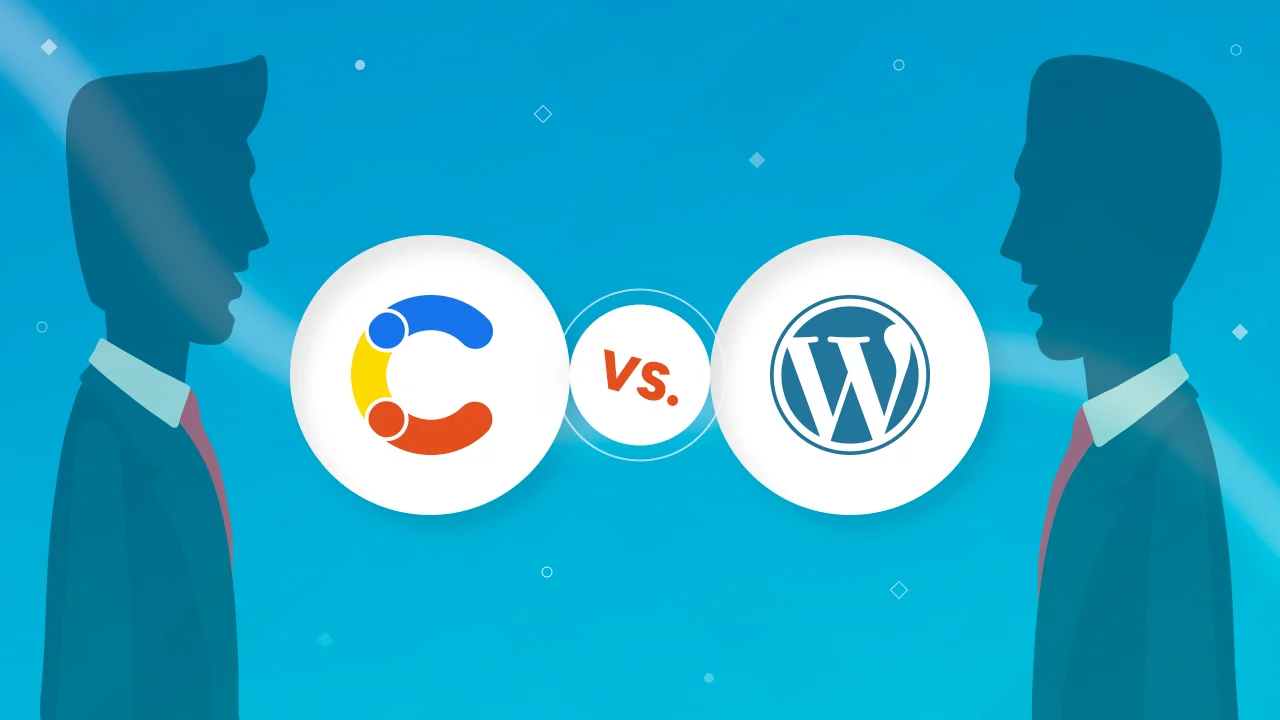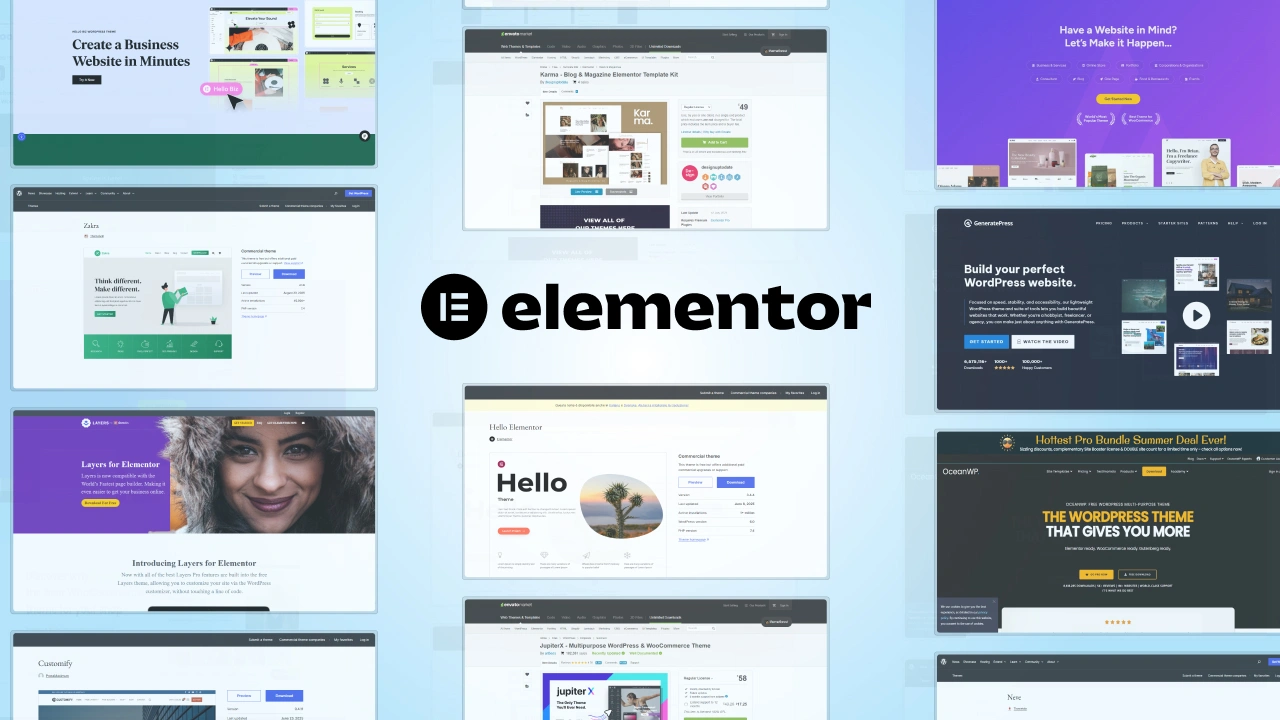There’s no shortage of options to help you get your website up and running.
However, picking the well-suited one can be tricky. This is especially true if you’re contemplating between two popular choices: WordPress vs Contentful.
Luckily, there’s a way to make this choice a little less intimidating. In this article, we’ll introduce you to the basics of Contentful and WordPress. Not just that, we’ll walk you through five major elements that you might want to consider before you opt for one over the other.
We will compare WordPress vs Contentful in a few key areas, such as:
- Platform for web content management software
- User community, user, role, and access management
- SEO, flexible navigation structures, internationalization
- Enterprise scalability, API/Integrations, dashboards, and reports
What is Contentful?
Contentful is a headless content management system that’s both cloud-based and highly adaptable to your needs.
It acts as the core of a modern tech stack, organizing and structuring all your content. With Contentful, organizations can manage their content easily, deliver engaging experiences swiftly, and publish seamlessly across different channels.
Its CMS component takes care of content management, while its broader platform utilizes flexible APIs to distribute content effectively.
This approach enables a seamless digital experience by intelligently integrating features such as search and structured content into a cohesive whole.

What is WordPress?
WordPress is an extremely diverse content management system that supports millions of websites globally.
Initially released in 2003 as a blogging tool, WordPress has since expanded to become a full-fledged website builder. You can now use WordPress for personal blogs, small business websites, global news websites, and e-commerce stores.
WordPress is the most popular website tool due to its user-friendly nature that also facilitates interaction for novice website creators.
At the center, WordPress has a template system using which users can create and alter their website’s look; the platform has thousands of themes to pick from, all having numerous functionalities and design styles.
Moreover, the platform has a plugin architecture with which users can embed several features into their website, for instance, SEO tools, social media tools, website optimization and protection tools, etc.
Since it is an open-source system, WordPress’s community has contributed to the growth of various themes, templates, and plugins. Its ease of use contributes to the high preference.
Features of Contentful and WordPress
Overall, Contentful, and WordPress prove to be powerful content management systems, each catering to a specific range of user requirements and processes. Thus, Contentful, with its API-first approach, is most suitable for developers who deal with various compliance requirements across numerous platforms. For its part, Contentful has the following core unique features:
- CMS Headless Architecture: The platform allows content to be separated from its display context, thereby enabling the delivery of content across a variety of front-ends, such as web, mobile, and IoT devices.
- Rich Text Editor: The service’s editor involves creating rich text and media embedded in the document.
- Content Custom Modeling: Users can establish their structures for the content, which implies organizing all items in logical order-information parameters for efficient use.
- Multi-Language Support: In Contentful, it is possible to create content in various languages for dealing with groups of global customers.
- Extensible Integrations: The platform offers seamless integration with various third-party systems by tightening cooperation with numerous services and speeding up work through extensions and plugins.
On the contrary, WordPress is most suitable for user-friendly compliance processes and various add-ons, which help from simple bloggers to enterprises. Therefore, WordPress demonstrates the following main features:
- Themes and plugins: WordPress enjoys a variety of themes and plugins, which provide plenty of opportunities for users to create the design and functionality of the site.
- SEO-friendly: This platform is created in such a way to support SEO, having plugins like Yoast SEO to reach higher rankings and optimized content.
- User access controls: The service offers a role system to all users that access the platform, and managers may restrict the access of some roles to go to certain website pages.
- Built-In Blogging: WordPress provides an original blog platform with powerful capabilities that allow users to become bloggers and maintain blogs more easily.
- Community: As WordPress is open-source, it has a large community that may upload themes, and plugins, and regularly update the original source code.
Thus, Contentful and WordPress meet a wide array of digital needs, from delivering content across various digital platforms to the website publishing process, allowing both developers and content creators to create unique digital storytelling experiences.
Contentful vs WordPress: a comparison
Comparing Contentful and WordPress as Web Content Management Systems, it is clear that each system has its own unique strengths which cater to different parts of the website development and management process.
Here’s how they compare when it comes to content management, design capabilities, platform architecture, and pricing.
-
Content delivery and management:
-
User community, user, role, and access management
-
SEO and flexible structures
-
Enterprise scalability, API/Integrations, dashboards, and reports
-
Designing capabilities:
-
Pricing
Contentful is known for its strong content management system capabilities, which center around a headless architecture that allows for independent creation, organization, and delivery of content from the front end.
Therefore, it is perfect for enterprises seeking to distribute their materials across various channels without interruption. Among the many features that make this possible includes; visual modeler and easy control over complicated structures of text through visualization.
On the other hand, WordPress has more usual CMS methods but still with great emphasis on extensibility and user-friendliness.
Here content production comes together with design so that people who don’t have any technological background can manage their websites by themselves using only visual editor experience while updating them frequently.
As for content management systems, community support and user management are crucial. Thus we observe how Contentful and WordPress address these issues.
Contentful has a vivid community forum featuring questions, knowledge sharing, and presentations. This website is valuable not only for typical forums that facilitate seeking advice from fellow users but also offers a direct tie to the Contentful team that can be addressed directly. It features a strong roles and perm rights system that regulates access and content change attempts.
Roles offer a summary of activities that may be executed by a user within some domain, regardless of whether it is a space, an environment, or the whole organization.
You may use Contentful’s predefined roles or make your own in accordance with your requirements. To interact with your content, you need to use Contentful’s APIs. To retrieve content, use the Content Delivery API, and to render changes, use the Content Management API. Don’t forget to get and control your API keys and credentials to maintain your authorization level security.
WordPress, in contrast, is used by the vast majority of websites all over the globe and thus maintains a huge community with active use and discussion to improve the CMS and provide additional features.

User management, in fact, plays a vital part in many WordPress websites. This ranges from eCommerce sites and membership to blogs or news resources. While users allow the editing of particular website parts, they can also be a considerable risk, especially in the multi-user setup.
Hence a user management strategy is, eventually, critical. Such a strategy plan will assist you in controlling possible hazards while ensuring proper security and access usage. In WordPress, the part of user management largely relies on user roles. A role is a collection of capabilities, given a title and capability enabling disabled by the admin.
The Contentful system is cloud-based and API-oriented, which means it can be scaled up and down easily for developers. Moreover, this multi-environment deployment also supports staging and production workflows that are essential.
Contentful doesn’t use plugins, Contentful Apps are like plugins — but far more powerful — extending and expanding the capabilities of the Contentful web app. There are dozens of apps in Contentful’s marketplace that can help level up and streamline your SEO efforts.
WordPress can either be self-hosted or hosted on WordPress.com. This flexibility allows users to choose the most suitable option depending on their knowledge of technology and the resources available. Though commonly used for small to medium-sized projects, WordPress can expand if provided with an appropriate hosting environment alongside expert configuration.
To integrate with content management systems, there is a need to be flexible. For platforms that do not have pre-built integrations with Contentful, you must be prepared to get your hands on the deck and write custom code to authenticate and interact with their APIs.
Use an appropriate programming language for your platform – JavaScript for web-based projects, Swift for iOS apps, and others. It then uses API endpoints provided by Contentful to be able to fetch or update content entries depending on your business needs. Fortunately, Contentful provides libraries to make your work easier while integrating with its API. With a little coding, the integration will be seamless into your stack.
Other than that, Contentful offers built-in analytics and tracking features that help have an overview of content performance and use by customers. As such, organizations can make informed decisions, a competitive advantage for the organization.
When it comes to content management, there isn’t an exact approach that gives the best results, especially for enterprises. This is where Contentful fits, as it is a headless CMS and a composable content platform that provides the power, flexibility, and extensibility demanded by modern organizations.
Meanwhile, WordPress is good if looking for a traditional CMS, particularly for its search engine optimization features. WordPress includes on-page optimization features, including easy content creation, alt text management, and clean permalink structures, to help you maximize your website’s SEO potential.
Another advantage of WordPress is its scalable. If your website exceeds your current hosting plan’s resources, you can upgrade it or switch to a different web host.
This means your WordPress website can grow along with your business, allowing you to meet the needs of your audience over time.
Lastly, Contentful’s activity reports are ideal for being able to view the activity log data in context making it easier for one to quickly access the information needed in a format that is easy to digest. This makes it easier for one to keep an eye on the content management workflow and make decisions.
Contentful lacks design tools since it is only a CMS (content management system). Design comes from external systems or custom development which Contentful supports by giving APIs for delivering content to any design architecture created by developers.
WordPress stands out when it comes to design capabilities because it offers a wide selection of themes that can be customized through various plugins and widgets. Additionally, this platform supports drag-and-drop page builders such as Elementor which closely resembles Webflow’s integrated visual design tools hence enabling users to create visually appealing websites with real-time customization features.
As for pricing plans, Contentful has a range of packages at different levels starting from a free plan that works well with small projects and then moving upwards towards premium plans having more features like extra API calls, multiple roles, and extensive support. Their free plan includes up to 5 users and the basic plan starts from $300/month.

WordPress is an open-source software that can be used without paying any fees; however premium plans cost $4–$45/month. Running a WordPress site comes with costs such as hosting fees, domain registration charges, and sometimes payment for premium themes or plugins. The total amount spent depends on the scale of use and additional tools required
Contentful vs WordPress: Which one to go for?
Ultimately there can be no outright winner between Contentful vs WordPress. Both platforms have their strong points on which they excel.
If you need a traditional website up and running quickly without too much technical involvement WordPress is an easy-to-use option that is reliable as well.
Moreover; with a wide variety of themes and plugins available this also adds to convenience. However, if your project involves complex content structures that are needed across multiple sites or applications or even future technologies then there’s no beating the flexibility offered by Contentful in such cases.
Its headless approach coupled with being developer friendly allows one to customize front end experience where maximum control over it can be achieved. The final decision should depend entirely upon what your project needs are and what skills do members possess in the team.





